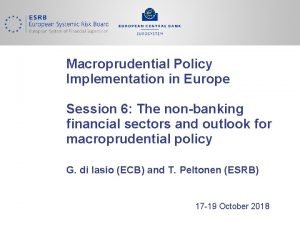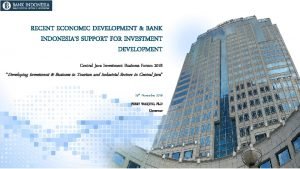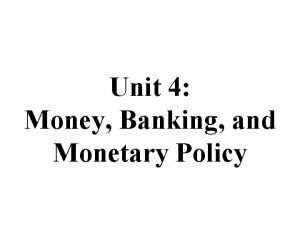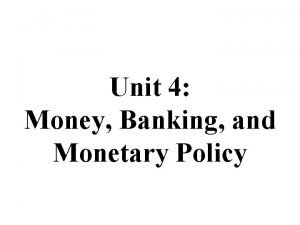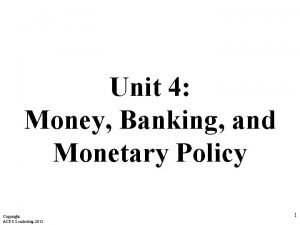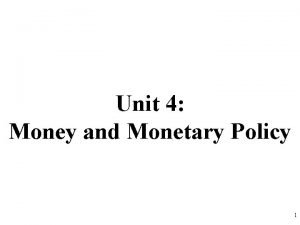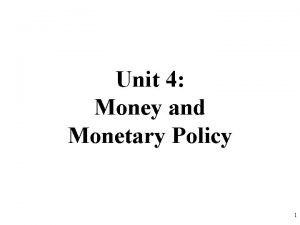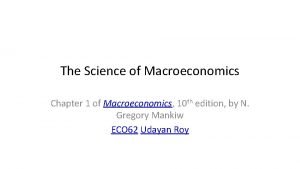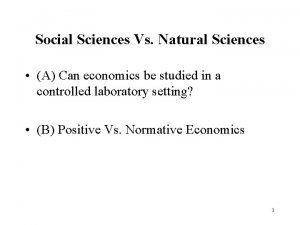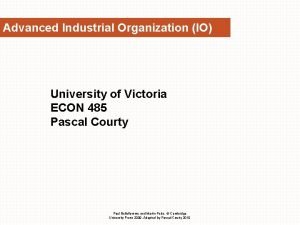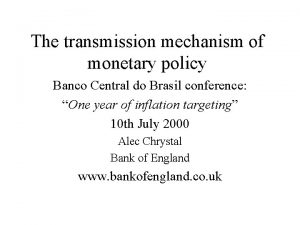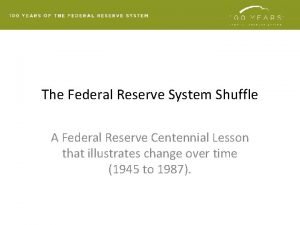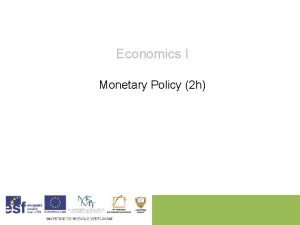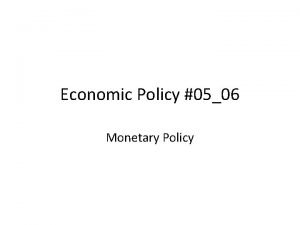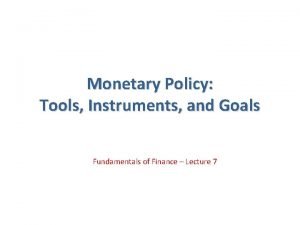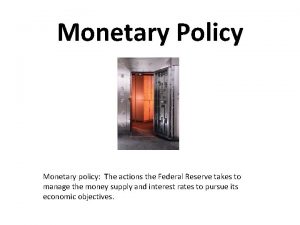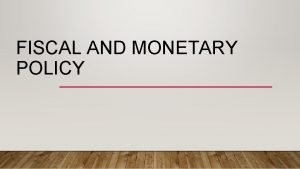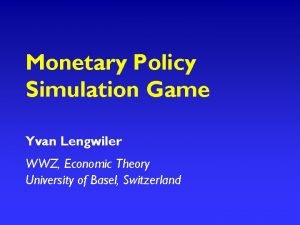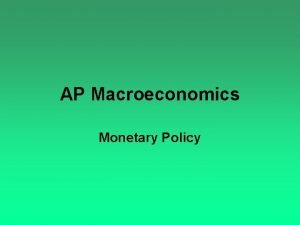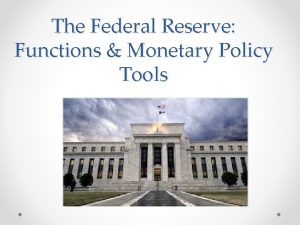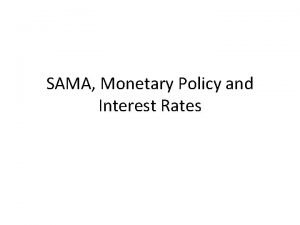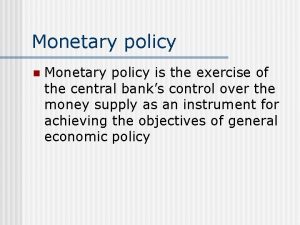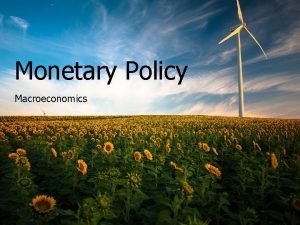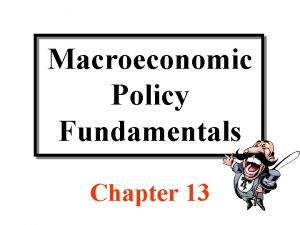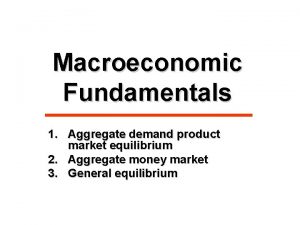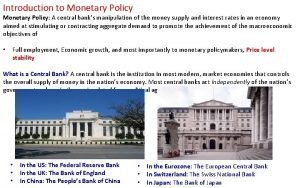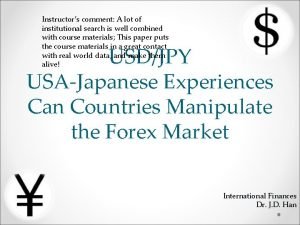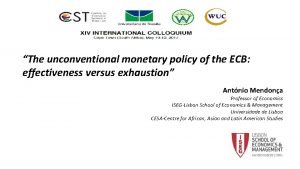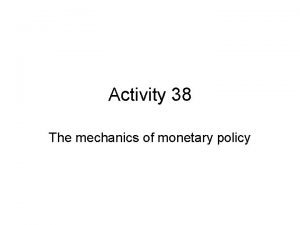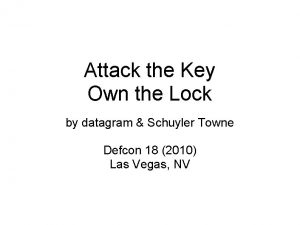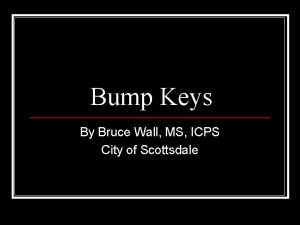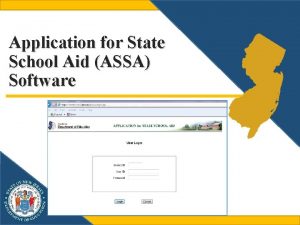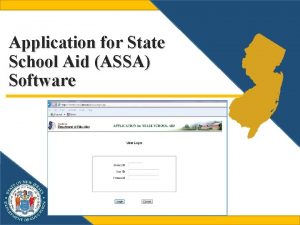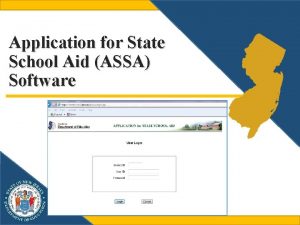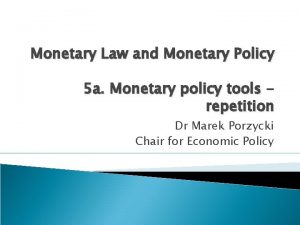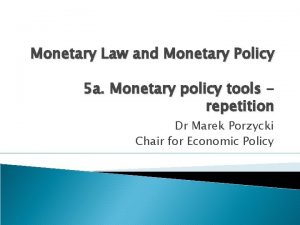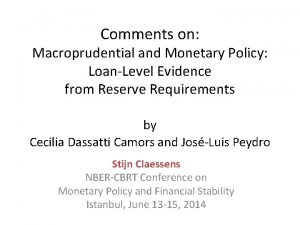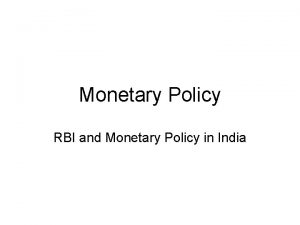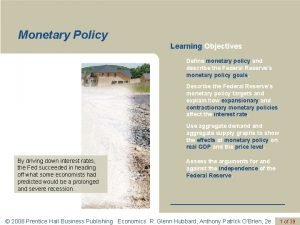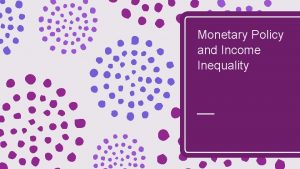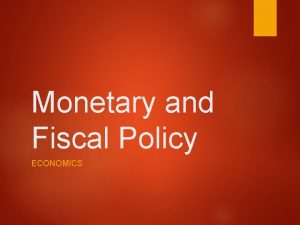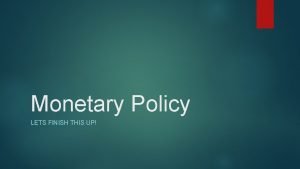MONETARY AND MACROPRUDENTIAL POLICY WITH ENDOGENOUS RISK ASSA










































- Slides: 42

MONETARY AND MACROPRUDENTIAL POLICY WITH ENDOGENOUS RISK ASSA ANNUAL MEETING, SAN DIEGO, JANUARY 5 TH, 2019 TOBIAS ADRIAN†, FERNANDO DUARTE ‡ , NELLIE LIANG ◊ AND PAWEL ZABCZYK† †INTERNATIONAL MONETARY FUND ‡FEDERAL RESERVE BANK OF NEW YORK ◊THE BROOKINGS INSTITUTION The views presented here are those of the authors and do not necessarily represent those of the International Monetary Fund or the Federal Reserve System

One-year-ahead distribution of GDP growth § Adrian, Boyarchenko, Giannone (2019) and Adrian, Grinberg, Liang and Malik (2018) document interesting regularities in the conditional distribution of GDP growth § Question: What are the implications of these new stylized facts for the conduct of policy? 2

Understanding shifts in conditional distributions § Assume, in line with the empirical estimates, that the conditional distributions are normal § For a normal distribution the formulae for the 95 th and 5 th conditional quantiles are given by § This implies 3

Conditional mean – conditional volatility scatterplot 4

Why should policy makers care? § Under flexible inflation targeting policy makers aim to affect the conditional mean of the output gap several quarters ahead § By pushing down on its conditional mean, the central bank will simultaneously be increasing the conditional volatility of the output gap §This trade-off, which has an intertemporal aspect, should be reflected in policy deliberations 5

Presentation Outline § Towards an NKV Model § Calibration and Fit § Policy Implications 6

What’s wrong with the standard NK model? § Let’s start with the simplest 3 -equation NK model (Woodford / Gali Ch. 3) 1. IS curve 2. Phillips curve 3. Policy rule 7

What’s wrong with the standard NK model? (ctd) § In any linear, homoscedastic model it will be the case that § It immediately follows that § I. e. crucially: conditional volatility would be constant! 8

Trade-off in a linear model 9

What’s wrong with the standard NK model? (ctd) § No immediate role for financial conditions… § Financial frictions on the borrower side give rise to a financial accelerator term in the IS curve § Tighter financial conditions (higher eta) push down on activity / are associated with a lower output gap 10

What’s wrong with the standard NK model? (ctd) § No immediate role for financial conditions… § Financial frictions on the borrower side give rise to a financial accelerator term in the IS curve § Tighter financial conditions (higher eta) push down on activity / are associated with a lower output gap § Financial conditions pin down heteroskedastic shock volatility § Motivation: work of Adrian and Duarte (2018) who focus on the role of occasionally binding Value-at-Risk (Va. R) constraints of financial intermediaries § Large values of make the economy “vulnerable” to shocks 11

Conditional quantile dynamics 12

Final NKV model specification § Just one N. i. d. shock, one extra equation, 5 new free parameters: 1. IS curve 2. Evolution of financial conditions 3. Phillips curve 4. Policy rule 13

Presentation Outline § Towards an NKV Model § Calibration and Fit § Policy Implications 14

Calibration § We constrain our exercise by assuming textbook values for all NK parameters § The remaining parameters selected to match autocorrelation of ΔYgap and its cross-correlation with ETA § To focus attention on macro-financial interactions we switch off productivity and monetary policy shocks § This is in line with Adrian & Duarte (2018) who restrict attention to an IS-curve wedge 15

Final Model Specification 1. IS curve 2. Evolution of financial conditions 3. Phillips curve 4. Policy rule 5. Parameter values 16

Stylized Fact I: Conditional Quantiles of ΔOutput Gap Data Simulation 17

Stylized Fact II: Conditional ΔOutput Gap Median and Volatility Correlate Negatively Data Simulation 18

Stylized Fact III: Conditional Quantiles of Inflation Data Simulation 19

Comparison of Simulated Conditional Moments ΔOutput Gap Inflation 20

Stylized Fact III: Conditional Inflation Median and Volatility Correlate Positively Data Simulation 21

Stylized Fact IV: Volatility Paradox Data Simulation 22

Stylized Fact IV: Volatility Paradox 23

Stylized Fact V: Term Structures of Growth at Risk Data Simulation 24

Presentation Outline § Towards an NKV Model § Calibration and Fit § Policy Implications 25

Policy Experiments: Conditioning on Expected FCI 26

Policy Experiments: Ergodic Output Gap Distribution 27

Policy Experiments: Conditioning on Expected FCI (ADJ) 28

Optimal Monetary Policy § Prior: In an NK model with a single IS curve disturbance the “divine coincidence” holds § Can sufficiently aggressive monetary policy also achieve full stabilization in the NKV model? § NO! § Once the coefficients on inflation and the output gap become too large, the model becomes unstable § In the NKV setup, monetary policy focused solely on inflation and the output gap risks destabilizing the economy! 29

Optimal Monetary Policy (ctd) § Consider the specification for financial conditions § The corresponding reduced-form specification equals § As monetary policy becomes increasingly efficient at stabilizing § But the “exogenous” component of the financial conditions specification, i. e. is itself an unstable AR(2) process § Original specification only stable because of the endogenous terms! § Blanchard-Kahn stability is a “first order” attribute, and so the result is unrelated to the presence / properties of the vulnerability function 30

Macroprudential Policy § Assume macroprudential tool financial conditions, i. e. that is capable of affecting contemporaneous § Further assume that macroprudential policy is specified as § With such policies in place, the dynamics of financial conditions under increasingly activist monetary policy would converge to § If this happens to be a “stable” process then full stabilization becomes possible again! 31

Macroprudential Policy (ctd) 32

Summary § We adapt the New Keynesian model to include “financial vulnerability” driven by movements in endogenous and forward-looking financial conditions § The resulting NKV model is calibrated to match macro-financial facts documented in Adrian, Boyarchenko and Giannone (2019) and Adrian, Grinberg, Liang and Malik (2018) § Our stylized model delivers three novel policy implications: § In contrast to the NK model, monetary policy aggressively targeting a combination of inflation and the output gap risks destabilizing the economy § Conditioning monetary policy on expected financial conditions can mitigate tail-risks § If macroprudential policy can ensure that financial conditions are “inherently stable” then a narrow mandate for monetary policy, i. e. focus purely on inflation and the output gap, can ensure full stability 33

Hidden Slides 34

How to specify vulnerability? § Consider: § The model variables are then conditionally distributed as § The conditional volatility of the first element of X can be shown to equal 35

How to specify vulnerability? (ctd) § Conditional normality gives us § To ensure that the conditional 95 th quantile of the first element of X is constant, we can combine these results and set v() equal to § Heteroskedastic adjustment is an affine function of the underlying state § In our baseline specification financial conditions are the only state variable § This allows for a direct link between financial conditions and the conditional volatility of the output gap 36

What’s wrong with the standard NK model? (ctd) § NK setup inherits many properties of the RBC model – including absence of a meaningful shock propagation mechanism § If we fed the model N. i. d. shocks we would get N. i. d. processes for the output gap and inflation… § Two potential solutions: § Increase the dimensionality of the state (e. g. habits, interest rate smoothing, accelerationist Phillips curve); however, in the spirit of Ascari, Fagiolo and Roventini (2015), this doesn’t improve fit to facts in ABG (2019) § Enrich shock propagation by allowing for richer dynamics of ETA §We opt for the latter and end up with a very rich propagation mechanism 37

The price for richer propagation… § Addition of an endogenous state variable makes all analytical expressions somewhat less tractable… § E. g. equilibrium coefficient on ETA lagged (with ληη set to zero), 2 MB function text file… 38

Calibration (ctd) § Can do more meaningful “conditional” analytics; since §Therefore 39

Stylized Fact V: Term Structures of Ga. R (Long Run) 40

Policy Experiments: Ergodic ΔOutput Gap Distribution 41

Unconditional US ΔOutput Gap Distribution 42
 Macroprudential policies
Macroprudential policies Macroprudential policy
Macroprudential policy Jisdor fixing
Jisdor fixing Unit 4 money banking and monetary policy
Unit 4 money banking and monetary policy Unit 4 money banking and monetary policy
Unit 4 money banking and monetary policy Contractory monetary policy
Contractory monetary policy Unit 4 money and monetary policy
Unit 4 money and monetary policy Unit 4 money and monetary policy
Unit 4 money and monetary policy Unit 4 money and monetary policy
Unit 4 money and monetary policy Endogenous variables
Endogenous variables Endogenous variables and exogenous variables
Endogenous variables and exogenous variables Advanced industrial economics
Advanced industrial economics Transmission of monetary policy
Transmission of monetary policy Lesson quiz 16-1 monetary policy
Lesson quiz 16-1 monetary policy What are the objectives of monetary policy
What are the objectives of monetary policy What is monetary policy
What is monetary policy Types of monetary policy
Types of monetary policy What are the objectives of monetary policy
What are the objectives of monetary policy Objectives of monetary policy
Objectives of monetary policy Expansionary monetary policy
Expansionary monetary policy Policy tools
Policy tools Monetary policy summary
Monetary policy summary Fiscal vs monetary policy
Fiscal vs monetary policy Monetary policy simulation game
Monetary policy simulation game Types of monetary policy
Types of monetary policy Instruments of monetary policy
Instruments of monetary policy Demand pull inflation
Demand pull inflation Moral suasion by central bank
Moral suasion by central bank Monetary policy
Monetary policy Tools of monetary policy ppt
Tools of monetary policy ppt Instruments of monetary policy
Instruments of monetary policy Expansionary monetary policy flow chart
Expansionary monetary policy flow chart Expansionary money policy
Expansionary money policy Expansionary money policy examples tagalog
Expansionary money policy examples tagalog Contractionary money policy
Contractionary money policy Features of fiscal policy ppt
Features of fiscal policy ppt Ecb unconventional monetary policy
Ecb unconventional monetary policy Monetary policy baseline
Monetary policy baseline Sfic ucsd
Sfic ucsd Assa abloy catalogue
Assa abloy catalogue Bump key assa
Bump key assa Protech assa abloy
Protech assa abloy Assa abloy lock configuration tool
Assa abloy lock configuration tool

